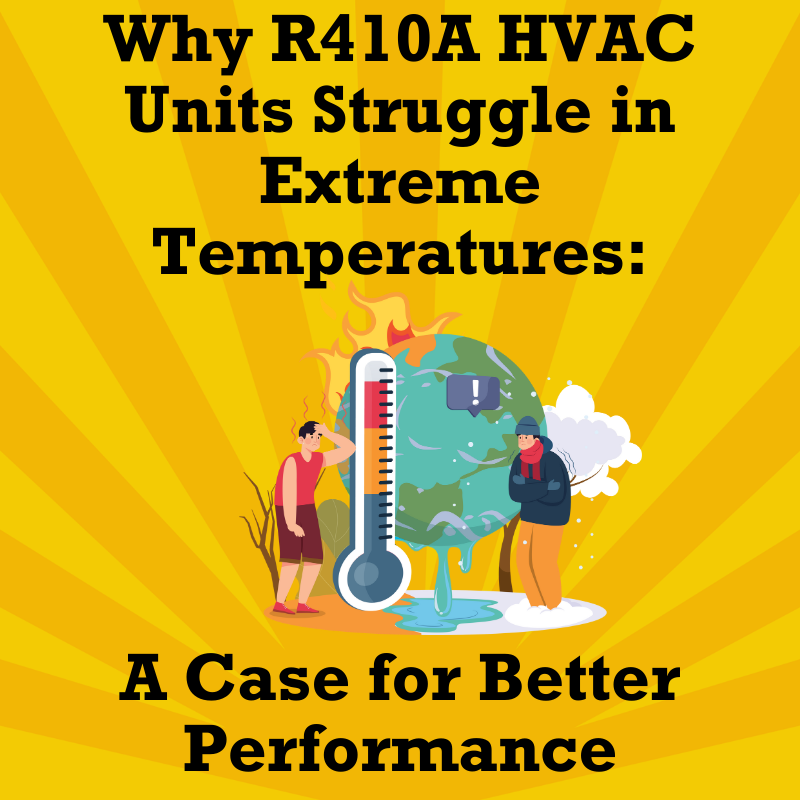As global temperatures continue to rise, the demand for reliable and efficient HVAC systems has never been greater. However, not all air conditioning units are equipped to handle the increasing frequency and intensity of extreme temperatures. Among the commonly used refrigerants, R410A, while popular for its ozone-friendly properties, has been shown to struggle in extreme heat and cold. This limitation raises important questions about the suitability of R410A HVAC systems for the future and highlights the need for better-performing alternatives.
The Rise of R410A in HVAC Systems
R410A became the standard refrigerant in residential and commercial HVAC systems as a replacement for R22, which was phased out due to its ozone-depleting properties. Marketed under names like Puron, R410A is a hydrofluorocarbon (HFC) that offers zero ozone depletion potential, making it a significant improvement over older refrigerants. However, despite these environmental benefits, R410A units face significant challenges when operating in extreme temperatures.

Discover Top-Grade Air Conditioners: View Our Products Today
-
High Pressure and Temperature Sensitivity
R410A operates at higher pressures than its predecessor, R22. While this allows for better heat transfer under normal conditions, it becomes a disadvantage in extreme temperatures. In very hot weather, the increased pressure can cause the system to overwork, leading to higher energy consumption, reduced efficiency, and potential system failure. On the flip side, in extremely cold temperatures, R410A systems can struggle to maintain efficiency, as the refrigerant's ability to absorb and release heat diminishes. -
Strain on System Components
The high-pressure operation of R410A systems puts additional strain on key components such as compressors, condensers, and evaporators. This strain is exacerbated during extreme weather conditions, where the system must work harder to maintain desired indoor temperatures. The result is not only reduced efficiency but also a higher likelihood of component failure. In the long term, this can lead to increased maintenance costs and a shorter lifespan for the HVAC system. -
Increased Energy Consumption
During periods of extreme heat, R410A systems often consume more energy to achieve the same level of cooling. This is because the system must work harder to overcome the thermal load imposed by high outdoor temperatures. The increased energy demand not only leads to higher utility bills but also puts additional strain on the electrical grid, which can be particularly problematic during heatwaves when demand for electricity is at its peak.
Case Study: The Impact of Extreme Heat on R410A Units
Consider a typical summer heatwave in a region like the southwestern United States, where temperatures can easily exceed 100°F for several consecutive days. During such extreme conditions, R410A HVAC units are often pushed to their limits. Homeowners may notice that their air conditioning systems are running continuously, yet struggling to maintain a comfortable indoor temperature. In some cases, the systems may even shut down due to pressure-related safety mechanisms, leaving occupants without cooling during the hottest part of the day.
These scenarios highlight the limitations of R410A in extreme heat. Not only do these systems struggle to maintain efficiency, but they also pose a risk of unexpected breakdowns, which can be both inconvenient and costly.
The Case for Better Performance: R32 and Other Alternatives
Given the challenges associated with R410A, it's clear that a more robust solution is needed—one that can perform reliably under extreme temperature conditions. This is where refrigerants like R32 come into play. R32 offers several advantages over R410A, including:
- Lower Global Warming Potential (GWP): R32 has a GWP of 675, significantly lower than R410A’s GWP of 2,088. This makes R32 a more environmentally responsible choice.
- Better Performance in Extreme Temperatures: R32 systems operate at lower pressures than R410A, reducing the strain on components and improving efficiency, even in extreme heat or cold. This results in more consistent performance and fewer breakdowns.
- Higher Energy Efficiency: R32’s superior heat transfer properties mean that HVAC systems can achieve the same or better cooling with less energy. This translates to lower energy bills and reduced environmental impact.
Preparing for the Future
As extreme weather events become more common, the need for HVAC systems that can perform reliably in all conditions is increasingly important. While R410A played a crucial role in the transition away from ozone-depleting refrigerants, its limitations in extreme temperatures make it less suitable for the future. Upgrading to systems that use refrigerants like R32 can offer better performance, greater energy efficiency, and improved resilience against the challenges posed by extreme weather.
Conclusion
R410A HVAC units have been a significant step forward in reducing ozone depletion, but their performance in extreme temperatures leaves much to be desired. With rising global temperatures and more frequent heatwaves, it’s clear that the next generation of HVAC systems needs to be more robust and efficient. Refrigerants like R32 offer a compelling case for this evolution, providing better performance in extreme conditions and a more sustainable option for homeowners and businesses alike. If you’re looking for an R32 product coming soon we suggest the Goodman 3 Ton 16.4 SEER2 R32 Air Conditioner Condenser.







